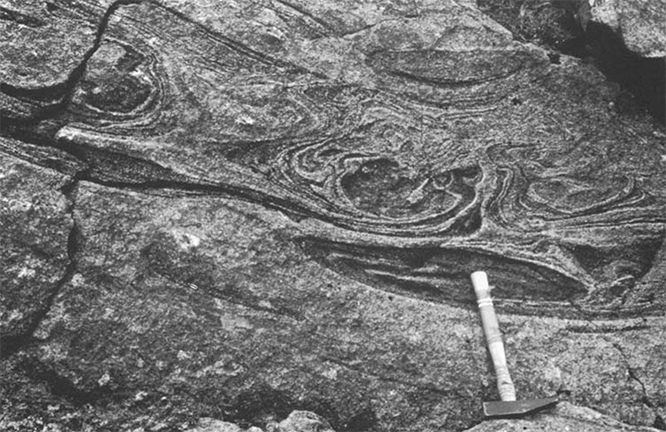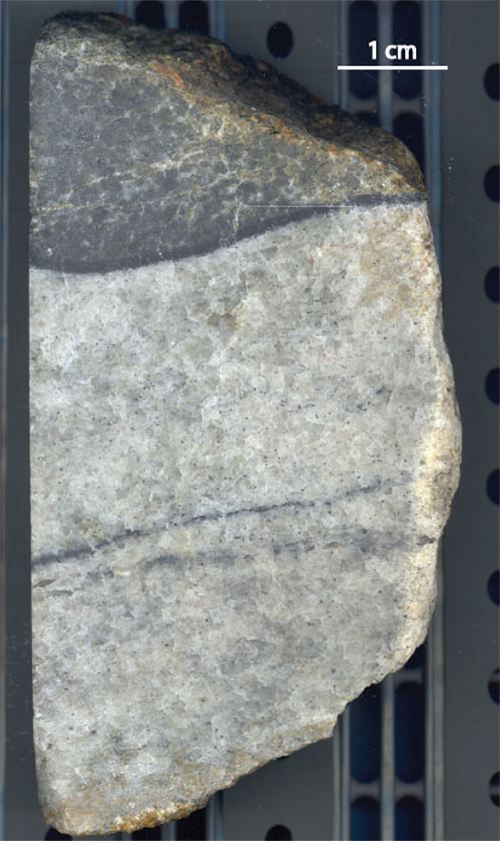Rhum Layered Complex
The Isle of Rum (or Rhum) (Fig.1), NW Scotland, lies on a NE–SW-trending ridge of Torridonian sandstone and Lewisian gneiss basement, and lies between Mesozoic basins to the west and east. The Rum Layered Suite, intruded during the Palaeogene opening of the North Atlantic Ocean, has long been regarded as a classic example of a layered mafic intrusion that formed by open-system magmatic differentiation. Early petrological studies of these rocks contributed significantly to the development of the fundamental crystal settling and cumulus theory of Wager et al. (1960).
Fig 1: General geological map of the Isle of Rum showing the main components of the Paleocene igneous centre, NMZ (Northern Marginal Zone), SMZ (Southern Mountains Zone), PL (Priomh Lochs), F (Fiachanis). From Emeleus (1997).
Intrusion of magma during Early Paleocene times is inferred to have caused doming at the Rum center; Lewisian gneiss and basal members of the Torridonian succession inside the ring fault were uplifted, by up to 1.7 km, and juxtaposed against much younger members of the Torridonian Applecross Formation. Doming was succeeded by felsic ignimbrite eruptions, caldera collapse and the intrusion of shallow-level microgranites. Igneous activity culminated in the intrusion of a major ultrabasic magma chamber system.
The Layered Suite of the Rum Central Complex (Fig.1) comprises the Eastern and Western Layered Intrusions and the Central Intrusion.
The rocks of the Eastern Layered Series (Fig.2) in the Askival-Hallival site comprise a repeated succession of large-scale layered ultrabasic units. Each unit is composed of a basal feldspathic peridotite rich in cumulus olivine (and sometimes pyroxene) which is overlain by, and sometimes gradational into, a plagioclase-rich, troctolitic cumulate termed allivalite. Less commonly, extreme plagioclase cumulates, or anorthosites, may occur at the very top of a unit. Brown (1956) distinguished, in the Eastern Layered Series in the Askival-Hallival, fifteen such units ranging in thickness from under 10 m to over 80 m.
The Western Layered Intrusions consists largely of peridotite. Age relations of the Eastern Layered Intrusions and Western Layered Intrusions are uncertain; although the Western Layered intrusions is structurally lower, it is separated from the Eastern Layered Intrusions by the younger Central Intrusion. The Central Series also consists predominantly of peridotite, with subordinate troctolite and gabbro. The Eastern Layered Intrusions is bounded by acid volcanic rocks of the NMZ ( Northern Marginal Zone) and SMZ (Southern Mountains Zone), and in the east by Proterozoic Torridonian sandstone and shale. The Eastern Layered Intrusions is separated from all of these by a narrow zone of variable width (generally less than 30 m), consisting of partly melted country rock, intrusion breccia and hybrid rocks.

Fig 2: Layered allivalite (light) and peridotite (dark) high in the Eastern Layered Series ultrabasic rocks, Hallival. Askival-Hallival site, Rum. (Photo: C.H. Emeleus.)
.jpg)
Fig 3: Ultrabasic layered rocks making up Askval (foreground) and Hallival (background)
The terraced topography which characterizes the slopes of Askival and Hallival (Fig.2; Fig.3) results from the contrasting weathering properties of peridotite and allivalite; the allivalites form prominent, resistant escarpments, while the peridotites erode more easily forming the grass-covered terraces.
The allivalites and peridotites are mineralogically simple, containing variable proportions of Mg-rich olivine, diopsidic pyroxene, calcic plagioclase and chrome-spinel. The petrographic textures reflect cumulate processes (Wager et al., 1960) and all minerals occur as cumulus phases; plagioclase in particular defines a strong lamination parallel to layering in allivalites.
The upper troctolitic part of the cyclic units is typically well-layered at a centimetre scale, the layers differing slightly in texture and/or modal mineralogy. Apart from a sporadic mineral lamination, defined by tabular (cumulus) olivine crystals, the peridotite portions of units do not usually exhibit small-scale structures. Cumulus chrome-spinel, commonly an accessory mineral in peridotite, is frequently concentrated in seams several millimetres thick at the very base of peridotite layers marking the abrupt unit boundaries.

Fig 4: Fine-scale layering in allivalite, west side of Hallival. (Photo: A.P. McKirdy.)
Allivalites commonly are rhythmically layered (Fig.4) and frequently contain zones of slump deformational structures; a particularly good example is exposed on the eastern face of Askival (Fig.5). Such structures are of a similar nature to those observed in unlithified sediments and suggest the accumulation of considerable thicknesses of poorly consolidated crystal cumulates on, or near to, the floor of the magma chamber. Slumping of the unstable magmatic sediments may have been triggered by tectonic activity.

Fig 5: Slumped folding in allivalite, near Askival summit, (Photo: A.P. McKirdy.)
The spectacular large-scale cyclic layering has been subject to intensive investigation concerning its origins. Recently, interest has been focused on detailed petrographic and geochemical studies and the refinement of theories relating to the formation of such rocks.
The layered rocks of eastern Rum are interpreted to be the result of successive pulses of magma injected into a shallow-level magma chamber. This magma is currently argued to have been of a picritic composition. Each pulse, or replenishment of new magma, is envisaged to have produced a single unit by high-temperature crystal accumulation on the floor of the magma chamber (Wager and Brown, 1951).
Successive pulses of new magma crystallized in this way to build up the Layered Series. Recent studies have proposed that pulses of new picritic magma ponded at the base of the chamber beneath cooler, less-dense residual magma. Initial olivine crystallization in the picritic liquid lowered its density, and it was cooled against the older magma above. The resulting temperature and density differences are thought to have caused strong convection to develop in the picritic layer culminating in the mixing of the two magmas when their physical properties equilibrated following the fractionation of a peridotite layer. With further cooling, the resulting magmas formed allivalitic and other troctolitic gabbroic rocks until the next pulse of picritic magma was injected and the cycle repeated.

Fig 6: Replenishment by basaltic liquid followed by fractional crystallization
The Rum complex differs from other classic layered intrusions such as the Skaergaard in that there is little or nothing of a marginal border group. Instead, the layered ultrabasic rocks are often bounded by rather variable gabbroic rocks which usually, but not always, separate them from the earlier Tertiary intrusions and Torridonian sediments. Marginal gabbros are exposed in the stream sections of Allt na h-Uamha and Allt Mor na h-Uamha in the east of the site. The gabbros have intruded along the line of the older Main Ring Fault near these streams and south to Allt nam Bà. In an investigation of the margin of the Ultrabasic-gabbroic complex, Greenwood (1987) suggested, on the basis of detailed mineralogical and geochemical studies as well as a consideration of the field relations, that the Marginal Gabbro was probably not a distinct, separate body from the main succession of ultrabasic rocks but that it represented various degrees of modification of the more feldspathic ultrabasic rocks through reaction with country rocks. Extensive intrusion breccias are commonly developed at the contacts with earlier, more acid rocks (for example, Torridonian near Allt na Uamha); rheomorphic acid magmas generated at these contacts may well have reacted with partially crystallized mafic magmas to give the very variable gabbroic rocks that characterize the Marginal Gabbro zone of earlier workers.

Fig 6: Hand-specimen section of a layered rock of Ruhm. Troctolite (White), Peridotite (Green), Cr-Spinel (Dark). Immagine tratta da B. O’Driscoll (2010)
(1).jpg)
Panoramic view of a layered rock Thin section from Ruhm. Image by Andy Tindle (Virtual Microscope). PPL image, field of view = 2.5cm.
(2).jpg)
Panoramic view of a layered rock Thin section from Ruhm. Image by Andy Tindle (Virtual Microscope). XPL image, field of view = 2.5cm.
Sample kindly given to me by Robert Gill.
Bibliography
• I.M.Young; R.C.Greenwood; C.HDonaldson (1988): Formation of the Eastern Layered Series of the Rum Complex Northern Scotland. Canadian Mineralogist Vol. 26; pp. 225-233.
• G. Nicoll; M. Holness; V. Troll; E. Holohan; C. H. Emeleus; David Chew (2009): Early mafic magmatism and crustal anatexis on the Isle of Rum: evidence from the Am Mam intrusion breccia. Geol. Mag. 146 (3), 2009, pp. 368–381.
• B. O’Driscoll; C. H. Emeleus; C. H. Donaldson; J. S. Daly (2010): Cr-spinel Seam Petrogenesis in the Rum Layered Suite, NWScotland: Cumulate Assimilation and in situ Crystallization in a Deforming Crystal Mush. Journal of Petrology, Vol. 51, N. 6, pp. 1171-1201


.jpg)
.jpg)
.jpg)
.jpg)
.jpg)
.jpg)
.jpg)
.jpg)
.jpg)
.jpg)
.jpg)
.jpg)
.jpg)
.jpg)
.jpg)
.jpg)
.jpg)
.jpg)
.jpg)
.jpg)
.jpg)
.jpg)
.jpg)
.jpg)
.jpg)
.jpg)
.jpg)
.jpg)
.jpg)
.jpg)
.jpg)
.jpg)
.jpg)
.jpg)
.jpg)
.jpg)
.jpg)
.jpg)
.jpg)
.jpg)
.jpg)
.jpg)
.jpg)
.jpg)
.jpg)
.jpg)
.jpg)
.jpg)
.jpg)
.jpg)
.jpg)
.jpg)
.jpg)
.jpg)
.jpg)
.jpg)
.jpg)
.jpg)
.jpg)
.jpg)
.jpg)
.jpg)
.jpg)
.jpg)
.jpg)
.jpg)